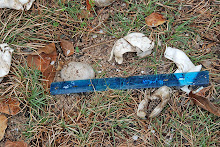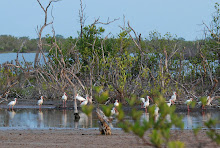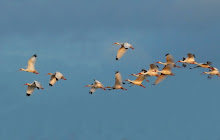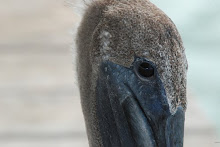Sunday, December 5, 2010
Mangroves that protect San Pedro Town are Threatened.
As Hurricane Keith battered San Pedro for two and a half days in October, some residents received first hand lessons on how effective mangroves can be at dissipating the strength of storm waves. Martin Hoffmann of the Tres Cocos area saw his house being hit with six foot waves while other homes in this neighborhood did not receive any or only minimal wave damage. Hoffmann explains that his house lies in front of a large swath of land that has been cleared of all mangrove coverage in anticipation of a future housing being built. Like wise the little town of San Pedro was protected by a barrier of mangroves directly behind it. This life saving barrier from hurricanes has been sold to Developer David Mitchel.Click to see more
Saturday, November 20, 2010
Wednesday, October 13, 2010
Friday, October 1, 2010
Ambergris Caye Citizens for Sustainable Development

One of the biggest challenges facing Ambergris Caye is how to balance environmental protection with the temptations of powerful foreign developers. It’s not just a problem for Ambergris Caye, the entire of Central and South America are being preyed upon by North American developers and industry that have been blocked by laws regulating their environmentally unsound practices in their own countries and have now moved their operations to a more naïve arena where profit can be maximized because of the absence of environmental considerations and government controls.
The young and inexperienced governments like Belize are succumbing to the enticements of proposals made by these experienced foreigners.
On the up-side, the past several decades has seen citizens and environmental groups, or non-governmental organizations (NGOs), pulling together to pressure governments to pass laws to protect the environment.
In the past decade, NGOs have applied a diverse array of strategies to counter negative influences including promoting laws to protect the environment, developing lawsuits against governments and developers.
In my opinion these third party intervention groups like the Ambergris Caye Citizens for Sustainable Development are the only realistic hope of controlling the impending disaster from uncontrolled development on our isla bonita.
If you love this place like I do meeting attendance, membership fees and contributions to environmental defense funds managed by reputable groups like the ACCSD is our best way of showing it.
Monday, September 6, 2010
Mangroves at Mata Lagoon

They act as feeding and nursery grounds for approximately 74 species of fish and 178 bird species. They provide habitat for 11 species of amphibians, 30 reptile species and 40 species of mammals. They stabilize soil and serve to dissipate wave energy. Mangroves provide many important ecological and physical functions and despite their importance and the legislation that protects them, it is not surprising to learn that the overall mangrove cover in Belize is decreasing, as this is a worldwide trend.
Friday, September 3, 2010
Mangroves and Coastal Lagoons
The mangroves and coastal lagoons of Belize are arguably the most productive and important ecosystem for the continuing health of the marine coastal zone. Belize has one of the largest mangrove lagoon systems in the Americas.
While the biodiversity of the mangrove habitat is relatively low when compared to the broadleaf forest, it is the biological processes the mangrove facilitate that define its importance. The flow of water drops its sediment load on the bacteria rich bottom. The bacteria transform the nutrients into food in the form of their bodies, which are fed upon by microscopic invertebrates, which are in turn ingested by macro invertebrates like crabs, shrimps and larvae fish. The process continues on up the food chain to the top predators - tarpon, snook, egrets, reptiles, small mammals and manatee.
The structure of roots, detritus and leaves form the perfect substrate to hide the young of most sea creatures, making the mangrove habitat the nurseries of the sea.
There are four mangrove species in Belize, all partitioning the mangrove habitat according to their biological needs. The red mangrove (Rhizophora mangle) is the pioneer species which can tolerate salt water better than any other mangrove. It's stilt roots are usually found half submerged along most of the shoreline of Belize. Immediately behind the red mangrove grows a zone of black mangrove (Avicennia germinans). The black mangrove is the true transition plant between land and water. The distinguishing characteristic of the black mangrove are the pencil thin root extensions called pneumatophores which rise out of the anoxic mud. They often form thick mats at the base of the trunk and are used to take in oxygen. Further inland grow the white mangrove (Laguncularia racemosa) and the buttonwood (Conocarpus erecta) which is not a true mangrove, but a common associate of mangrove swamps.
While the biodiversity of the mangrove habitat is relatively low when compared to the broadleaf forest, it is the biological processes the mangrove facilitate that define its importance. The flow of water drops its sediment load on the bacteria rich bottom. The bacteria transform the nutrients into food in the form of their bodies, which are fed upon by microscopic invertebrates, which are in turn ingested by macro invertebrates like crabs, shrimps and larvae fish. The process continues on up the food chain to the top predators - tarpon, snook, egrets, reptiles, small mammals and manatee.
The structure of roots, detritus and leaves form the perfect substrate to hide the young of most sea creatures, making the mangrove habitat the nurseries of the sea.
There are four mangrove species in Belize, all partitioning the mangrove habitat according to their biological needs. The red mangrove (Rhizophora mangle) is the pioneer species which can tolerate salt water better than any other mangrove. It's stilt roots are usually found half submerged along most of the shoreline of Belize. Immediately behind the red mangrove grows a zone of black mangrove (Avicennia germinans). The black mangrove is the true transition plant between land and water. The distinguishing characteristic of the black mangrove are the pencil thin root extensions called pneumatophores which rise out of the anoxic mud. They often form thick mats at the base of the trunk and are used to take in oxygen. Further inland grow the white mangrove (Laguncularia racemosa) and the buttonwood (Conocarpus erecta) which is not a true mangrove, but a common associate of mangrove swamps.
Thursday, September 2, 2010
Wednesday, September 1, 2010
Wednesday, August 18, 2010
Wednesday, June 23, 2010
Sunday, May 9, 2010
Monday, April 12, 2010
Friday, March 19, 2010
Saturday, March 13, 2010
Friday, March 12, 2010
Friday, February 19, 2010
Thursday, February 18, 2010
Basilisk Lizard
Wednesday, February 17, 2010

Small fish move with the tides to access mangrove areas, where they find protection, and to the salt marsh, where some feed. Mangroves shade water and sediment, buffering temperature and blocking UV radiation, providing a habitat for other organisms.
Some fish move upstream and downstream, to fresh and marine water habitats at different stages of their life cycles to breed and spawn. Mangroves are important nursery areas for some juvenile fish and crustacean larvae.
Water flow between wetland pools and estuaries during very high tides or run-off events allows fish to move between these habitats. Many organisms in estuarine wetlands live in burrows or on the sediment, including worms and microbes.
Friday, January 1, 2010
Subscribe to:
Posts (Atom)
 http://peanutcaye.blogspot.com/
http://peanutcaye.blogspot.com/
 Amer. Croc mother
Amer. Croc mother 























